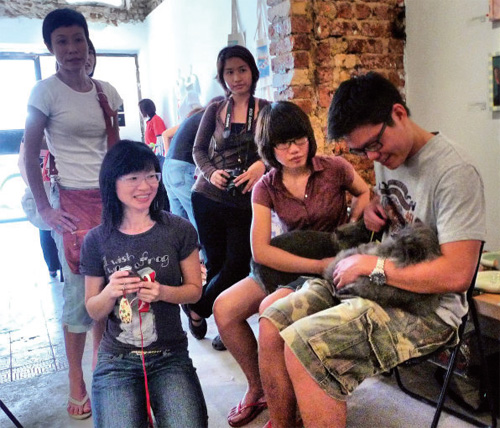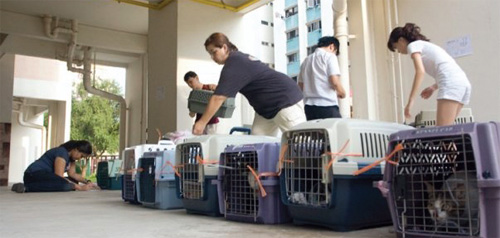The Cat Welfare Society addresses the issue of cruelty and abuse of community cats in Singapore.
 Did you know that in Singapore, 13,000 community cats have been put down every year for the past 20 years? This equates to 35 cats killed every single day.
Did you know that in Singapore, 13,000 community cats have been put down every year for the past 20 years? This equates to 35 cats killed every single day.
Yet, all it takes is a little education and awareness to stop the needless and unnecessary culling of cats. That is the mission of the Cat Welfare Society—a charity run almost entirely by volunteers hoping to improve the welfare of community cats in Singapore.
The society was formed in July 1999 when five friends, after reading about the plight of some kittens being burned alive in a box, decided to take a stand against the senseless acts of cruelty towards innocent cats in Singapore. And so, the Cat Welfare Society was formed.
The mission of CWS, as stated on their website, is “To Save Lives Through Sterilisation.”
“We realized that the only way to help alleviate suffering and to stop so many cats from being killed is to go to the root cause of the problem—which is that of too many unwanted cats being born. Abandonment will continue to be a chronic issue as long as people are not sterilizing their pets,” explained Veron Lau, vice president of CWS.
CWS works with volunteer residents, town councils, management committees as well as caregivers to administer a sterilization program called TNRM—Trap, Neuter, Return, Manage. In this program, volunteers are lent traps to capture stray cats, and are reimbursed for bringing these cats to be sterilized by vets, before returning the cats to the community. This program helps to manage the stray cat population around housing estates in Singapore.
The society believes that education is key to increasing the awareness of responsible pet ownership and responsible community cat management amongst the general public. To that end, CWS regularly conducts awareness talks on the importance of sterilization to schools, resident committees and other establishments.
Lau believes that many people have misconceptions about community cats as being wild, filthy and disease-carrying. Community cats are also perceived as a nuisance to residents with their frequent caterwauling, territorial peeing, as well as aggressive fighting.
“These acts are often tied to mating behaviors. By sterilizing the community cats, many of these behaviors can be eliminated,” explained Lau.
Besides sterilization, another important message which CWS wants to bring across to the community is that of responsible pet ownership. The rise inthe stray cat population can often be attributed to abandonment, with the root cause being irresponsible pet ownership.
 |
| PHOTO COURTESY OF WELFARE SOCIETY |
“Once a decision is made to buy or adopt a cat as a house pet, it should be a long-term commitment,” reiterated Lau.
“A responsible pet owner will keep the cat indoors, neuter it when of age, provide it with adequate love and care, and most importantly, love it for life and never abandon it,” he continued.
Lau shared that even with a more educated populace, it is not uncommon to chance upon cases of abandoned or abused cats. He highlights two abuse cases the society had to deal with recently.
“Late last year, there was a strangulation case in Toa Payoh where a cat was tethered to a pipe until it was asphyxiated. It was extremely sad and horrifying to witness this unfortunate incident,” said Lau.
“More recently, we came across a case in which 10 cats were found in a diseased, skinny and starving state. The cats were abandoned by a family that did not know about the need for sterilization and let the cats breed to the point where they did not have the means to care for them,” he continued.
So what should one do when one witnesses an act of cruelty against community cats or an abused cat?
“Eyewitnesses should call the police or SPCA to report the animal abuse or if resources permit, bring the cat to the nearest vet for urgent medical treatment,” said Lau.
If possible, one should also take photos of the perpetrator and note down details of the abuse. To bring the culprit to justice, Lau advised that it is imperative that the eye-witnesses come forward to help in the police investigation.
For those interested in helping abused cats or to learn how to manage the community cat population in their estates, CWS conducts regular workshops on fostering and caregiving to help volunteers get started. In addition, the society is also on a constant lookout for volunteers and interns to help at their events, which range from fundraisers to sterilization or adoption drives.
For more information, please log onto www.catwelfare.org.
Spay Day On Oct. 29
Community cats are often invisible to us in our busy lives, until they pose a problem. Do we think about how they got there or why they stopped appearing one day? Have we come to accept the cycle of abandonment, breeding and destruction as an inevitable way of life for these stray cats?
A life of a cat need not be so misused and worthless when there are humane alternatives. The Cat Welfare Society promotes sterilization as a vital personal responsibility of a cat owner and an effective means to control the community cat population. One of its most successful schemes is its sterilization reimbursement scheme that encourages people who care to do their part for their communities and their community cats.
CWS is holding its annual Spay Day on Oct. 29 where free sterilizations will be provided to encourage more people to do their part. Last year, 210 community cats were sterilized in one day. That is 210 lives improved and thousands of unwanted cat births prevented. This year, CWS has set a goal of 300 cats for Spay Day 2010.
To join or donate to Spay Day 2010, please log on to www.catwelfare.org/drupal/node/3150.
